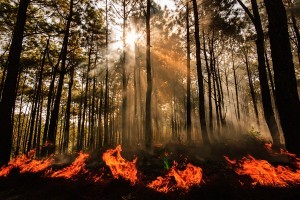Creation of a catastrophic wildfire risk pool is emerging as the most likely option as California lawmakers seek to protect the solvency of investor-owned utilities from record payouts for fire damages.
PG&E filed for a bankruptcy reorganization this year, saying it needed the court’s protection because it cannot count on the California Public Utilities Commission to allow it to recoup its costs through rates. The legislature last year created the Commission on Catastrophic Wildfire Cost and Recovery, which is due to recommend ways of mitigating wildfire risks by July 1. Gov. Gavin Newsom is also drafting plans to respond to wildfires more broadly and is expected to release a proposal late next week.
 One potential solution would be to change laws that California courts have interpreted to assign strict liability to investor-owned utilities inverse condemnation actions, which are lawsuits against public entities. The courts have assigned liability to insurers irrespective of fault if their equipment causes fires. But legislation to reform inverse condemnation rules failed to pass the state legislature last year.
One potential solution would be to change laws that California courts have interpreted to assign strict liability to investor-owned utilities inverse condemnation actions, which are lawsuits against public entities. The courts have assigned liability to insurers irrespective of fault if their equipment causes fires. But legislation to reform inverse condemnation rules failed to pass the state legislature last year.
Moody’s on Wednesday issued a report saying that creation of a state catastrophe fund “appears to be the reform that is most likely to happen.” Analyzing several possible remedies, the ratings house said an independent fund could provide an “immediate source of liquidity for utilities addressing wildfire claims and allow for financial stability during times of crises.”
“California’s application of inverse condemnation effectively turns the state’s investor-owned and publicly owned electric utilities into an insurance backstop,” said Jeff Cassella, a vice president at Moody’s. “When wildfires occur now, investors face significant uncertainty regarding the ability of utilities to recover related costs in a timely manner.”
Standard and Poors and Fitch have also warned state lawmakers that they will continue to downgrade the credit ratings for the state’s utilities unless lawmakers and regulators craft a solution to protect investors from catastrophic costs.
James Woods, an insurance attorney and industry lobbyist who was active in the creation of the California Earthquake Authority, said Wednesday that efforts to create a catastrophic wildfire and mudslide fund are taking shape in Sacramento. He said Sen. Robert Hertzberg, a well-placed Democrat, is in talks with Assemblyman Chad Mayes, the Republican author of legislation, Assembly Bill 235, that would create a catastrophic wildfire fund. The two are hoping to present a detailed plan to the governor within 30 to 60 days, he said.
Hertzberg was speaker of the state Assembly during California’s energy crisis in 2001 and has been a senator for the past four years. He is chairman of Senate Committee on Natural Resources and Water and a member of several other committees.
“I think the significance is that Mayes is going to lead the bill,” Woods said. “I think that’s fabulous that we have bipartisan support here.”
Woods said the proposed catastrophe fund would likely set aside $20 million to $30 million. The money would come from taxpayers, the utilities and rate payers, he said.
Insurance lobbyist John Norwood said as long as California courts continue to interpret inverse condemnation laws as imposing strict liability on utilities for fire damage caused by their power lines, there aren’t very many good options. He said the difficulty in creating a catastrophic wildfire fund is that it has to be replenished as damages are paid out.
“PG&E had $100 million in insurance,” he said. “If you want to go to Lloyds and you want a $10 billion fund, they will probably tell you it will cost you $9 billion and there is a $1 billion deductible.”
Norwood said he doesn’t see how a catastrophe fund will be any help to insurers. He said while insurers banded together to create the California Earthquake Authority to protect individual carriers from catastrophic payouts, he said wildfire risk is not like earthquake risk. California hasn’t suffered a major earthquake in a decade, while wildfires blaze every year and losses continue to grow.
Eleven of the 20 most destructive fires in California’s history have occurred since 2015, with five occurring in 2017 alone, according to a preamble to Mayes’ bill.
Utilities expressed their own doubts about the feasibility of a catastrophic wildfire fund in comments to the commission that is studying the issue, which met Tuesday in Santa Rosa.
Caroline Choi, senior vice president of corporate affairs for Edison International, said in a letter to the commission that it supports creation of a wildfire recovery insurance fund. But she also said that any “cost socialization” needs to be accompanied by reform of inverse condemnation rules. She noted that Southern California Edison is paying nearly $200 million more in interest than utilities outside of California would have paid for a $1.1 billion bond issue earlier this year.
“Without a predictable objective process for timely cost recovery at the CPUC, the existing strict liability framework applied to wildfire damages when ignition is substantially caused by utility infrastructure has damaged the utilities’ financial health, which will result in higher customer rates,” she said.
*This story appeared previously in our sister publication Claims Journal.





















 Insurance Costs, Climate Concerns Factor Heavily in U.S. Home Buying Decisions
Insurance Costs, Climate Concerns Factor Heavily in U.S. Home Buying Decisions  Breaking: Andersen to Replace Zaffino as CEO of AIG on June 1
Breaking: Andersen to Replace Zaffino as CEO of AIG on June 1  Nearly Half of 100 Largest P/C Insurers Destroy Value: ACORD
Nearly Half of 100 Largest P/C Insurers Destroy Value: ACORD  Slideshow: Carrier Management’s 2025 Top Editor’s Picks (Unlocked)
Slideshow: Carrier Management’s 2025 Top Editor’s Picks (Unlocked) 



